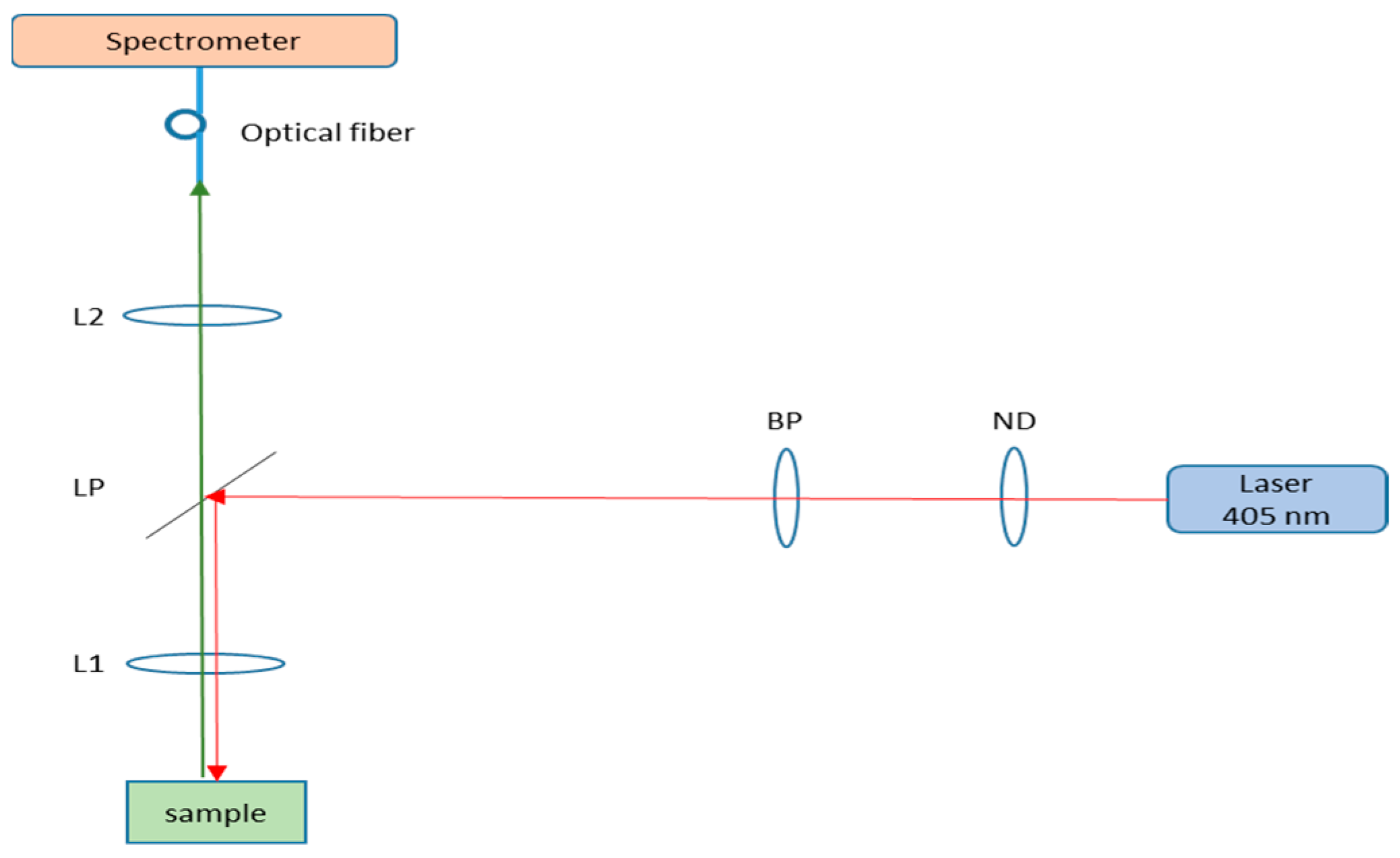The Detection of Plastic and Petroleum Hydrocarbon Pollution at Sea with Laser-Induced Fluorescence †
Abstract
:1. Introduction
2. Materials and Methods
3. Results and Discussion
4. Conclusions
Author Contributions
Funding
Institutional Review Board Statement
Informed Consent Statement
Data Availability Statement
Acknowledgments
Conflicts of Interest
References
- Cheng, P.; Zhu, Y.; Cui, C.; Wang, F.; Pan, J. Determination of oil pollutants by three-dimensional fluorescence spectroscopy combined with improved pattern recognition algorithm. Meas. Control 2022, 55, 1078–1087. [Google Scholar] [CrossRef]
- De Haan, W.P.; Sanchez-Vidal, A.; Canals, M. Floating microplastics and aggregate formation in the Western Mediterranean Sea. Mar. Pollut. Bull. 2019, 140, 523–535. [Google Scholar] [CrossRef] [PubMed]
- Pampanin, D.M.; Sydnes, M.O. Chapter 5: Polycyclic aromatic hydrocarbons a constituent of petroleum: Presence and influence in the aquatic environment. In Hydrocarbon; Kutcherov, V., Kolesnikov, A., Eds.; Intech Open Ltd.: London, UK, 2013; pp. 83–118. Available online: https://www.intechopen.com/chapters/41885 (accessed on 1 September 2022).
- Shim, W.J.; Hong, S.H.; Eo, S.E. Identification methods in microplastic analysis: A review. Anal. Methods 2017, 9, 1384–1391. [Google Scholar] [CrossRef]
- Prata, J.C.; da Costa, J.P.; Duarte, A.C.; Rocha-Santos, T. Methods for sampling and detection of microplastics in water and sediment: A critical review. Trends Anal. Chem. 2019, 110, 150–159. [Google Scholar] [CrossRef]
- Zhou, F.; Wang, X.; Wang, G.; Zuo, Y.A. Rapid Method for Detecting Microplastics Based on Fluorescence Lifetime Imaging Technology (FLIM). Toxics 2022, 10, 118. [Google Scholar] [CrossRef] [PubMed]
- Fatemeh, S.M.; Soucy, N.; Hollebone, B.P.; Brown, C.E. Rapid fingerprinting of spilled petroleum products using fluorescence spectroscopy coupled with parallel factor and principal component analysis. Chemosphere 2018, 208, 185–195. [Google Scholar] [CrossRef]
- Ornik, J.; Sommer, S.; Gies, S.; Weber, M.; Lott, C.; Blazer, J.C.; Koch, M. Could photoluminescence spectroscopy be an alternative technique for the detection of microplastics? First experiments using a 405 nm laser for excitation. Appl. Phys. B 2020, 126, 15. [Google Scholar] [CrossRef]
- Lotter, B.; Konde, S.; Nguyen, J.; Grau, M.; Koch, M.; Lenz, P. Identifying plastics with photoluminescence spectroscopy and machine learning. Nat. Sci. Rep. 2022, 12, 18840. [Google Scholar] [CrossRef]
- Merlemis, N.; Kesidis, A.L.; Sianoudis, I. Measurement of laser beam spatial profile by laser scanning. Eur. J. Phys. 2020, 42, 015304. [Google Scholar] [CrossRef]





| Material | Origin | Material | Origin |
|---|---|---|---|
| PMMA-Poly(methyl methacrylate) | Industry | Naval oil SAE 40—new | Shipping industry |
| Polyethylene (PE) | Industry and retail | Naval oil SAE 40—used | Shipping industry |
| Polypropylene (PP) | Industry | Fuel oil VLSFO | Shipping industry |
| Polystyrene | Industry and retail | Fuel oil HSFO | Shipping industry |
| PET-Polyethylene terephthalate | retail | Paint SKF9005 | Shipping industry |
| Polyurethane (PUR) | retail | Wood (Palm tree) | Natural |
| PVC-Polyvinyl chloride | retail | Olive Oil | Natural |
| Polycarbonate (PC) | retail | Posidonia Oceanica | Natural |
| Bakelite | retail | PEEK GF30 Glass Fibre 30% | Retail |
Disclaimer/Publisher’s Note: The statements, opinions and data contained in all publications are solely those of the individual author(s) and contributor(s) and not of MDPI and/or the editor(s). MDPI and/or the editor(s) disclaim responsibility for any injury to people or property resulting from any ideas, methods, instructions or products referred to in the content. |
© 2023 by the authors. Licensee MDPI, Basel, Switzerland. This article is an open access article distributed under the terms and conditions of the Creative Commons Attribution (CC BY) license (https://creativecommons.org/licenses/by/4.0/).
Share and Cite
Drakaki, E.; Zekou, E.; Serris, M.; Merlemis, N. The Detection of Plastic and Petroleum Hydrocarbon Pollution at Sea with Laser-Induced Fluorescence. Environ. Sci. Proc. 2023, 26, 12. https://doi.org/10.3390/environsciproc2023026012
Drakaki E, Zekou E, Serris M, Merlemis N. The Detection of Plastic and Petroleum Hydrocarbon Pollution at Sea with Laser-Induced Fluorescence. Environmental Sciences Proceedings. 2023; 26(1):12. https://doi.org/10.3390/environsciproc2023026012
Chicago/Turabian StyleDrakaki, Eleni, Evangelini Zekou, Michail Serris, and Nikolaos Merlemis. 2023. "The Detection of Plastic and Petroleum Hydrocarbon Pollution at Sea with Laser-Induced Fluorescence" Environmental Sciences Proceedings 26, no. 1: 12. https://doi.org/10.3390/environsciproc2023026012
APA StyleDrakaki, E., Zekou, E., Serris, M., & Merlemis, N. (2023). The Detection of Plastic and Petroleum Hydrocarbon Pollution at Sea with Laser-Induced Fluorescence. Environmental Sciences Proceedings, 26(1), 12. https://doi.org/10.3390/environsciproc2023026012






